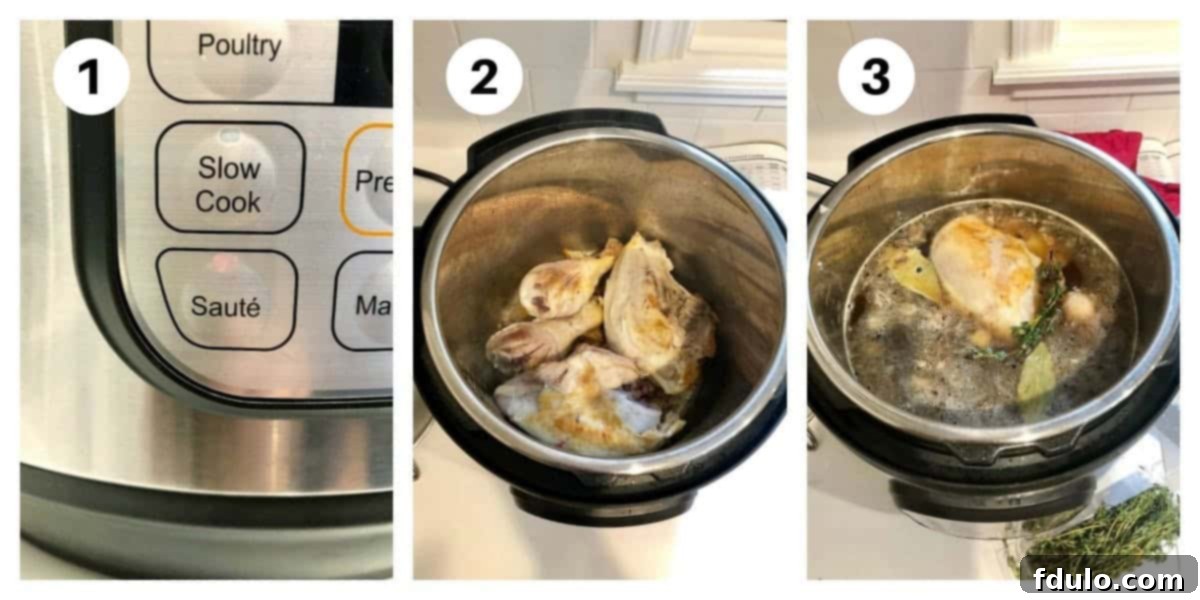Experience the unmatched richness and depth of flavor with Homemade Instant Pot Chicken Stock. By harnessing the power of pressure cooking, every essence is meticulously captured, transforming simple ingredients into a culinary masterpiece in record time. Say goodbye to store-bought cartons and elevate your cooking to extraordinary levels with this incredibly flavorful and versatile homemade broth.
The first time I tasted Homemade Chicken Broth prepared in a pressure cooker, I was genuinely astonished by its profound depth and clarity. It’s an absolute game-changer! With just a handful of fresh, high-quality ingredients and mostly hands-off cooking, you’ll discover an outstanding, intensely flavorful chicken stock that forms the perfect foundation for countless delicious dishes. This method ensures maximum flavor extraction and nutrient retention, making it a superior choice for any home cook.

Unlock Superior Flavor: Why Homemade Instant Pot Chicken Stock is a Must
There are countless reasons to make your own chicken stock, especially when utilizing the efficiency of an Instant Pot. This isn’t just a recipe; it’s an investment in your culinary journey, promising unparalleled results:
- **Unrivaled Taste and Quality:** Homemade stock boasts a flavor profile that generic store-bought options simply cannot match. By selecting fresh ingredients and controlling the cooking process, you create a complex, nuanced broth that will significantly enhance any recipe.
- **Maximum Flavor Extraction with Pressure Cooking:** The Instant Pot’s sealed environment prevents a single molecule of flavor from escaping during cooking. This unique pressure-cooking method extracts every bit of goodness from the bones, vegetables, and herbs, resulting in a remarkably rich and deeply concentrated stock. The elevated pressure also speeds up the breakdown of collagen, yielding a luxurious, gelatinous texture.
- **Nutritional Powerhouse:** This Instant Pot chicken broth recipe provides an extra delicious flavor boost that comes directly from chicken bones. These bones are packed with collagen, gelatin, and essential minerals like calcium, magnesium, and phosphorus. Homemade stock is a fantastic source of nutrients known to support gut health, joint function, skin elasticity, and immune response.
- **Cost-Effective and Sustainable:** Making stock from scratch is an excellent way to utilize leftover chicken carcasses, bones from roast chickens, and vegetable scraps that might otherwise go to waste. It’s a sustainable practice that saves money and reduces food waste, all while producing a superior product.
- **Control Over Ingredients:** When you make your own stock, you have complete control over what goes into it. This means no artificial flavors, preservatives, excessive sodium, or unwanted additives often found in commercially processed broths. You can tailor the seasoning to your exact preferences and dietary needs.
As the cooler months approach, our thoughts naturally turn to comforting dishes like hearty soups and stews. While your pantry might be stocked with convenient boxes or cans of chicken broth, opting for homemade Instant Pot Chicken Stock or Broth will undeniably elevate your culinary creations to the next level. It’s a million times better than anything you can purchase! Plus, for another incredibly tasty and quick meal, be sure to check out this Instant Pot Bang Bang Chicken recipe.
Step-by-Step Guide: Crafting Your Perfect Instant Pot Chicken Stock
Making chicken stock in an Instant Pot is surprisingly straightforward and incredibly rewarding. Follow these detailed steps to create a rich, flavorful, and nutrient-dense broth that will become a staple in your kitchen.
- **Prepare Your Ingredients:** Gather all your chicken pieces, vegetables (onions, carrots, celery), garlic, herbs (parsley, thyme), whole peppercorns, and salt. Chop the vegetables into large, roughly equal pieces to ensure even cooking and easy straining later.
- **Brown the Chicken for Depth of Flavor:** Set your Instant Pot to the “Saute” function on high heat. Add 1-2 tablespoons of vegetable oil. Working in batches if necessary due to the Instant Pot’s surface area, add the chicken pieces (whole chicken with giblets removed, or 3 pounds of bone-in white and dark chicken pieces). Brown them thoroughly on all sides until golden brown. This crucial step, known as the Maillard reaction, develops a complex, caramelized flavor that forms the backbone of an exceptional stock. Once browned, remove the chicken pieces to a clean bowl and set aside.
- **Deglaze and Build Fond:** The brown bits stuck to the bottom of the pot after browning the chicken (the “fond”) are pure flavor gold. Briefly sauté the chopped onion, carrots, and celery in the residual fat for 3-5 minutes until slightly softened. Then, add a splash of water (or a bit of the 12 cups you’ll add later) and scrape up all the flavorful fond from the bottom of the pot using a wooden spoon. This prevents a “burn” notice and incorporates all that deliciousness into your stock.
- **Combine All Ingredients:** Return the browned chicken to the Instant Pot. Add the remaining vegetables, smashed garlic cloves, fresh parsley sprigs, fresh thyme sprigs, ½ teaspoon of whole peppercorns, and 1 tablespoon of kosher salt. Finally, pour in 12 cups of cold water, ensuring the liquid does not exceed the maximum fill line of your Instant Pot.
- **Pressure Cook to Perfection:** Secure the Instant Pot lid, making sure the sealing ring is properly in place and the vent is set to “Sealing.” Select the “Manual” or “Pressure Cook” function (depending on your model) and set it to high pressure for 60 minutes.
- **Release Pressure Safely:** Once the cooking cycle is complete, you have two options for releasing pressure:
- **Natural Pressure Release (NPR):** Allow the pressure to release naturally for at least 15-20 minutes, or until the float valve drops on its own. This allows for a gentler release and often results in clearer stock.
- **Quick Release (QR):** Carefully turn the vent to the “Venting” position. Be extremely cautious as a significant amount of hot steam will be released. Use a kitchen towel or oven mitt to protect your hand and keep your face away from the vent. The pressure is fully released when the float valve drops.
Once the pressure is fully released and the float valve has dropped, open the lid away from your face.
- **Cool, Strain, and Defat:** Allow the stock to cool slightly within the pot to prevent splashing and ensure safer handling. Carefully remove the large chicken pieces and set them aside. Place a fine-mesh strainer over a large, heatproof bowl or another clean pot. Slowly pour the liquid through the strainer to remove all solid ingredients like vegetables, herbs, and peppercorns. Discard these solids (they have given all their flavor to the stock).
- **Utilize the Cooked Chicken:** Once the chicken is cool enough to handle, shred the meat from the bones. This cooked chicken is tender and incredibly flavorful, perfect for adding to soups, sandwiches, tacos, or salads. Store it separately in an airtight container in the refrigerator or freezer for future recipes.
- **Refrigerate and Remove Excess Fat:** For the clearest and most manageable stock, refrigerate the strained liquid overnight (or for several hours). As it chills, any excess fat will solidify on the surface, making it easy to skim off with a spoon. You can discard this fat or reserve it for other culinary uses, such as roasting vegetables or making savory pastries. Store reserved fat in a sealed container in the freezer for long-term use.
- **Store Your Homemade Stock:** Transfer the defatted chicken stock into appropriate storage containers. Depending on how soon you plan to use it, you can store it in the refrigerator for 3-4 days or freeze it in airtight containers, freezer bags, or ice cube trays for up to a year. Be sure to leave some headspace in containers if freezing liquid, as it will expand.

Expert Tips for the Most Flavorful Instant Pot Chicken Stock
Making incredible chicken stock is an art, but with these expert tips, you’ll achieve restaurant-quality results every time. Remember, the Instant Pot simplifies the process, making it accessible even for infrequent users!
- **Embrace the Maillard Reaction:** The browning of chicken pieces is not merely for aesthetics; it’s a critical step for developing deep, complex flavors. The Maillard reaction creates hundreds of new flavor compounds. Ensure your Instant Pot is preheated using the “Saute” function, and brown the chicken in batches to avoid overcrowding the pot, which would steam the chicken instead of browning it. Aim for a rich, golden-brown crust.
- **The Magic of Fond:** The dark, flavorful bits left on the bottom of the pot after browning are known as “fond.” This fond is priceless! It’s a concentrated essence of flavor that will be released into your stock when liquid is added (this process is called deglazing). Always make sure your fond is brown, not black. If it’s burnt, the resulting stock will have an undesirable underlying burnt flavor, so adjust heat accordingly. Deglazing properly with a splash of water or broth and scraping with a wooden spoon is key.
- **Choose Your Chicken Wisely:** While any bone-in chicken will yield stock, certain parts contribute more flavor. Dark meat (thighs, drumsticks, backs) generally adds more flavor and richness than white meat (breasts) due to higher fat content and connective tissue. A combination of both is often ideal, especially if you plan to use the shredded chicken for soups where breast meat is preferred. Using a whole chicken carcass or a mix of bone-in parts ensures a well-rounded flavor profile.
- **Don’t Overfill Your Pot:** Be mindful of the maximum fill line on your Instant Pot. Overfilling can be dangerous and prevent the pot from reaching proper pressure. Stick to the recommended 12 cups of water or adjust based on your specific Instant Pot model’s guidelines.
- **Safety First with Pressure Release:** When performing a quick release, always be mindful of the large amount of steam. Position your hand and face away from the vent, and consider using a long-handled spoon or a kitchen towel to turn the vent knob to prevent steam burns. Natural pressure release, though slower, is generally safer and can lead to a clearer stock.
- **Chill for Clarity and Defatting:** Chilling your stock completely allows any remaining impurities to settle and, more importantly, solidifies the fat cap on top. This makes it incredibly easy to remove excess fat, resulting in a clearer, more palatable, and healthier stock. You can then reserve this flavorful chicken fat (schmaltz) for other culinary uses, like roasting potatoes or making matzo ball soup.
- **Proper Storage is Key:** To maximize freshness and longevity, store your cooled stock in appropriate containers. For refrigerator storage (3-4 days), airtight containers are best. For longer-term storage (up to a year), freeze in portions using freezer-safe containers, heavy-duty freezer bags (laid flat), or even ice cube trays for smaller quantities perfect for deglazing or adding a flavor boost to sauces. Always label with the date.

Limitless Culinary Applications for Homemade Chicken Stock
Homemade chicken stock is a versatile liquid gold that can transform everyday meals into extraordinary culinary experiences. Its rich, savory flavor adds a depth that store-bought varieties can only dream of.
- **Soups and Stews:** This is where homemade stock truly shines. Using it as the base for your favorite chicken soup, hearty stews, or comforting chowders provides the biggest bang for your buck, creating dishes with incredible body and flavor. It’s no wonder some chicken soups are affectionately called “Jewish Penicillin” for their restorative properties!
- **Nourishment When Under the Weather:** When you’re feeling unwell, a steaming bowl of piping hot chicken broth or stock is more than just comfort food. Full of easily digestible nutrients, it’s gentle on your system, helps open sinus passages as you inhale its wonderful aroma, and provides hydrating warmth. It’s a natural remedy that has been cherished for generations.
- **Grain Cooking:** Elevate simple grains by cooking them in chicken stock instead of water. Rice, quinoa, couscous, and farro will absorb the rich flavors of the stock, becoming more savory and delicious side dishes or bases for other meals.
- **Sauces and Gravies:** Reduce homemade chicken stock to create intensely flavorful sauces for roasted meats, or use it as the liquid component in pan gravies. The gelatin from the bones will give your sauces a beautiful, silky texture and body.
- **Braising and Roasting:** Braise tough cuts of meat in chicken stock until they are fall-apart tender and infused with flavor. A splash of stock in a roasting pan can also help keep meats moist and create a flavorful drippings for gravy.
- **Risotto and Pasta Dishes:** For an authentic and creamy risotto, homemade chicken stock is essential. It provides the liquid needed for absorption while imparting a deep, savory character. A bit of stock can also enhance pasta sauces, adding richness and moisture.
- **Clear Liquid Diets:** If you find yourself needing to follow a clear liquid diet (e.g., before a colonoscopy), your homemade chicken stock is a nourishing and flavorful option – truly like drinking liquid gold!
Here are some specific recipes that truly benefit from the depth of homemade stock:
- Chili Blanca – a flavorful white chicken chili that gains incredible depth.
- Chicken Jambalaya Soup – a Mardi Gras favorite transformed into a rich and comforting soup.
- Chicken with Artichokes and Israeli Couscous – where the couscous is cooked directly in the flavorful broth.
- Creamy Chicken Marsala – the sauce is made even more luxurious with reduced chicken broth.
- French Onion Soup – a combination of chicken and beef broth provides an amazing depth of flavor for this classic.

Frequently Asked Questions About Instant Pot Chicken Stock
If you use these terms interchangeably, you’re certainly not alone, and for most home cooking, the “foodie police” won’t mind! However, for clarity, here are the general distinctions: Chicken broth is typically made primarily from chicken meat (with or without a few bones) simmered with aromatics, vegetables, and seasonings. It tends to be lighter in body and flavor. On the other hand, chicken stock is made predominantly from bony parts of the chicken, allowing for the extraction of both meat and bone flavors. The key difference is that stock becomes thicker and richer than broth due to the gelatin extracted from the bones. This gelatin gives stock its characteristic silky mouthfeel and helps it solidify when chilled. Stock also tends to be unseasoned, designed to be a neutral base, though I prefer to season mine lightly with salt, pepper, and garlic, making it more versatile like a seasoned broth.
Absolutely not! Collagen is the primary protein providing structure in skin, bones, and connective tissue. Far from destroying it, pressure cooking efficiently breaks down collagen into gelatin. This transformation is highly desirable, as gelatin is what gives homemade stock its rich body and nourishing qualities. When you chill your homemade Instant Pot chicken stock, its gelatinous consistency is a clear indicator of successful collagen breakdown.
Quite the opposite, in fact! A pressure cooker shortens cooking time by increasing the pressure within the pot, not by significantly increasing the temperature beyond typical boiling points. Because the pot is sealed, there’s minimal loss of nutrients via steam or evaporation. Studies suggest that pressure cooking actually leads to a high retention of nutrients, often around 90-95%, as vitamins and minerals are less likely to leach out or degrade compared to other cooking methods that involve longer exposure to heat and air.
Properly stored, homemade chicken stock is good for 3-4 days in the refrigerator. To maximize its shelf life, ensure it’s cooled quickly after cooking and stored in an airtight container. If you don’t plan to use it within that timeframe, stock freezes exceptionally well and can be kept in an airtight container in the freezer for up to a year without significant loss of quality.
Yes, absolutely! Using a frozen chicken carcass (or bones) is a fantastic way to make stock. Simply add the frozen bones directly to the Instant Pot along with your vegetables and water. The pressure cooker will handle the thawing and cooking process efficiently, extracting all the wonderful flavors and nutrients. There’s no need to thaw the carcass beforehand, making it even more convenient.
For a crystal-clear stock, there are a few tips:
- Avoid rapid boiling during the initial stages (though the Instant Pot handles this with pressure).
- Do not stir the stock excessively once it starts cooking.
- After cooking, let the stock settle for a bit before straining.
- Use a very fine-mesh strainer or even cheesecloth lined over a colander to filter out all small particles.
- Chilling the stock and skimming the fat will also contribute to its clarity.
A slightly cloudy stock is perfectly fine for most home cooking, as the flavor remains excellent.
Absolutely! This recipe provides a classic base, but feel free to customize it. You can add leeks, parsnips, mushrooms, or even a potato (peeled) for extra flavor. For herbs, bay leaves, sage, or rosemary can be wonderful additions. Just be mindful not to add vegetables like broccoli, cauliflower, or cabbage, as they can impart strong, sometimes undesirable, flavors to the stock. Root vegetables work best.

Instant Pot Chicken Stock Recipe
15 minutes
1 hour 15 minutes
1 hour 30 minutes
12 servings
A rich, flavorful stock made with bone in chicken, vegetables and seasonings!
Ingredients
- 1-2 tablespoons vegetable oil
- A whole chicken (giblets, etc. removed) or 3 pounds of bone in white and dark chicken pieces
- 1 large onion, chopped
- 2 carrots, peeled and cut into thirds
- 2 stalks of celery, cut into thirds
- 2-3 garlic cloves, peeled and smashed
- 5 sprigs fresh parsley
- 3 sprigs fresh thyme
- ½ teaspoon whole peppercorns
- 1 tablespoon kosher salt
- 12 cups water
Instructions
- Set your IP to saute and add vegetable oil. In batches, brown all the chicken pieces and remove to a bowl.
- When all the chicken is browned, return the chicken to the Instant Pot along with all the other ingredients.
- Select high pressure and set the timer to 60 minutes. When the timer goes off, turn off the IP and either let vent naturally or use the quick release (there will be a lot of steam!).
- When the pressure is released, remove the lid. Remove the chicken pieces to a clean bowl.
- Let the stock cool a bit before pouring through a fine-mesh strainer to remove the vegetables, herbs, and impurities.
- Cover the bowl and let cool in the refrigerator. When cool, scrape off any accumulated fat on the surface and divide it into storage containers.
- When the chicken is cool enough to handle, shred the meat and place it in storage containers to use in future recipes.
Notes
The stock can be stored in the refrigerator for 3-4 days or frozen up to one year
Recommended Products
As an Amazon Associate and member of other affiliate programs, I earn from qualifying purchases.
- Cuisinart Fine Mesh Strainers
- Santoku Knife
- OXO Cutting Board
- 8 quart Instant Pot
Nutrition Information:
Yield:
12
Serving Size:
1
Amount Per Serving:
Calories: 104Total Fat: 6gSaturated Fat: 1gTrans Fat: 0gUnsaturated Fat: 4gCholesterol: 44mgSodium: 584mgCarbohydrates: 2gFiber: 1gSugar: 1gProtein: 10g
HOW MUCH DID YOU LOVE THIS RECIPE?
Please leave a comment on the blog or share a photo on Pinterest
There you have it – a comprehensive guide to making the most incredible homemade Instant Pot Chicken Stock. This simple recipe will revolutionize your kitchen, providing you with a foundation of flavor and nutrition that store-bought versions simply can’t compete with. Embrace the journey of making your own stock; your taste buds (and your health) will thank you. Happy cooking!
